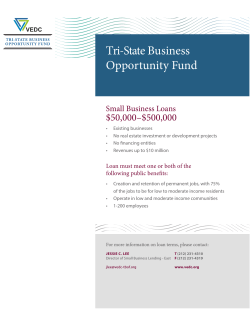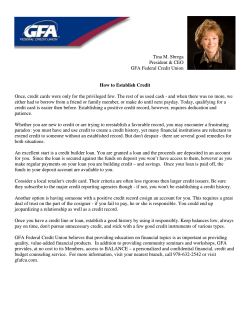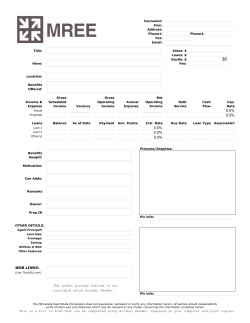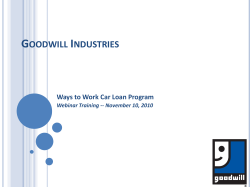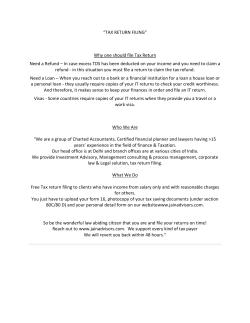
Discouraged In-need Borrowers - Annual International Real Options
Discouraged Bank Borrowers: A Real Options Perspective Konstantinos Drakos† and Andrianos Tsekrekos‡ Abstract A stylized empirical fact is the rather substantial portion of SMEs who although in need of bank credit, do not apply for a loan, due to fear of possible rejection. Non-applying in-need borrowers are known as 'discouraged borrowers'. We propose a new perspective for modelling discouraged potential bank borrowers, based on a Real Options explanation. A loan application decision is clearly not a 'now-or-never' decision, since the decision can be delayed. Hence the firm may be considered as holding a Real Option. Employing firm-level survey data that allow us to identify discouraged firms, as well as, constructing Real Options proxies we test whether discouragement is explained by Real Option factors. Our approach takes into account the selectivity, subject to which the discouragement phenomenon is observed, by modelling discouragement using a Bivariate Probit with selection setup. Our results, provide empirical support for the presence of Real Options effects in the discouragement process. Keywords: Bivariate Probit with Selection, Discouraged Borrowers, Real Options, Survey Data JEL classification: G01, G10, G30, G32 † (Corresponding Author) Associate Professor, Department of Accounting and Finance, Athens University of Economics and Business. Address: 76 Patission Street, 10434, Athens. Email: kdrakos@aueb.gr ‡ Assistant Professor, Department of Accounting and Finance, Athens University of Economics and Business. Address: 76 Patission Street, 10434, Athens. Email: tsekrekos@aueb.gr Introduction The heavy reliance of Small and Medium Enterprises (SMEs hereafter) on bank loans is a stylized fact encountered both in financially developed and less developed markets (Freel et al. 2012). Another stylized fact is the rather substantial portion of SMEs that although they need bank credit they do not apply for a loan, due to fear of possible rejection. Potential borrowers who do not apply, although in need of a loan, are known in the literature as 'discouraged borrowersi' (Jappelli, 1990; Cox and Jappelli, 1993; Piga and Atzeni, 2007) or 'preemptively rationed' borrowers (Mushinski, 1999). According to Kon and Storey (2003)discouraged borrowers exist because of both information asymmetries and positive application costs. The prevalence of the phenomenon has been documented empirically; with Levenson and Willard (2000) and Freel et al. (2012) reporting that there are twice as many discouraged borrowers as rejected borrowers in the US and the UK, respectively. Ferrando and Mulier (2014) focusing on Eurozone SMEs report that the discouragement rate is on average about 15%, and discouraged firms are about twice as many as rejected firms. Although discouraged SMEs are far from being a negligible quantity, there is a disproportionally thin empirical academic literature focusing on the issue. Moreover, the scant literature has so far explored what is the profile of the average 'discouraged' firm, typically considering firm-specific (financial and non-financial) characteristics. In what follows we propose to analyse the behaviour of 'discouraged' firms by adopting a Real Options perspective. A loan application decision is clearly not a 'now-ornever' decision, since the decision can be delayed. Hence the firm may be considered as holding a Real Option with regards to the decision to apply or not for a bank loan. If this is the case, factors affecting the value of this option will essentially also affect its exercise or not. Hence, the value of waiting would play a significant role in the decision to exercise the loan application option. 2 Thus the novelty of the present study is that highlights the real options aspect of discouragement, which to the best of our knowledge has not been proposed before. As a byproduct we link the real options and banking literatures. Our analysis will empirically investigate whether the observed variation across discouraged and non-discouraged firms can be accounted for by factors rendering value to the underlying real option. Data Issues and Background Analysis We employ data from the Survey of Access to Finance of Enterprises (SAFE), a firm-level survey launched in 2009 and conducted twice a year by the European Commission and the European Central Bank. In particular, we use the waves that correspond to the first halves of 2009, 2011, 2013, and 2014. We are particularly interested in those waves because they contain questions that enable us to capture the potential Real Options effects. Identifying discouraged firms Correct identification of discouraged firms is clearly a cornerstone for our analysis and as we will show it is also a delicate task. According to theory a firm, provided that needs a bank loan, is considered as discouraged if it did not apply for a loan because of fear of rejection. Hence, a salient feature of discouragement is its conditionality to the need of bank loan. This conditionality not only affects the measurement of discouragement per se, but also determines the estimation technique to be deployed. By combining the answers from two questions of SAFE we are in a position to empirically match the theoretical definition of discouragement, and therefore identify discouraged firms. Our starting point for this identification is based on the following survey question, which in the SAFE questionnaire is posed as follows (Q7A in survey questionnaire): 3 Could you please indicate whether you applied for a Bank Loan them over the past 6 months, or if you did not apply because you thought you would be rejected, because you had sufficient internal funds, or you did not apply for other reasons? - Applied - Did not apply because of possible rejection - Did not apply because of sufficient internal funds - Did not apply for other reasons - [DK/NA] Graph 1 depicts the distribution of answers provided by firms for the whole sample (across all waves and all countries)ii. About 40% of firms did not apply for a bank loan because they had sufficient internal funds, while just above 28% of firms applied for a bank loan. A combined 30% of firms answered that did not apply for a bank loan, being the sum of 5.99% of firms who stated the fear of possible rejection of their application as the reason for not applying and 23.58% stating that did not apply for other reasons. *****Graph 1***** As already mentioned, discouraged firms are necessarily a subset of firms who need a bank loan. In other words, discouragement is only observed conditional on a firm's need of a bank loan. From the above question we can easily classify a firm as needing or not needing a bank loan. Let ( N i ) be an indicator showing whether the i − th firm needs or does not need a bank loan, attaining the following values (excluding those firms who answered DK/NA): 0 if firm answered: 'Did not apply because of sufficient internal funds' Ni = 1 otherwise (1) Then we define ( D j ) as a dichotomous indicator that classifies the j − th firm as discouraged or not as follows: 1 if N = 1 and firm answered: 'Did not apply because of possible rejection' Di = 0 if N = 0 0 if N = 1 and firm answered: 'Applied' or 'Did not apply for other reasons' (2) The following table summarizes the sample properties of the need and discouraged variables: 4 *****Table 1***** We see that 53.82% of firms answered that they need a bank loan, while 46.18% answered that possess the necessary funds internally. Conditional on the need for bank loan, we see that 9.67% of firms are characterized as discouraged, i.e. although they need a bank loan they did not apply because of fear of possible rejection. Discouraged firms are a sizeable portion of in-need bank loan firms. To further gauge the prevalence of discouragement, it would be fruitful to compare it to another benchmark credit market outcome, namely the percentage of firms who applied for a bank loan but their application was rejectediii. This information is provided in another survey question (Q7B in SAFE questionnaire), and it turns out that firms whose loan application was rejected represent about 9.7% of the sample, which is almost identical to the percentage of discouraged firms. Thus, the occurrence of discouragement is as prevalent as Type-1 credit rationing. Graph 2 depicts for comparison purposes the prevalence of discouragement rate and loan application rejection rate across countries in our sample. *****Graph 2***** Proxying Real Option effects Below we present the construction of Real Options proxies. The survey question (Q1_c in SAFE questionnaire) asks firms the following: During the past 12 months have you introduced a new organisation of management? - Yes - No - [DK/NA] Thus we construct a dichotomous variable as follows: NEWMANAGEMENT = 1 if firm answered YES = 0 if firm answered NO. 5 We conjecture that firms who have introduced a new organisation in management face higher uncertainty and therefore are more likely to defer their bank loan application. Firms were also asked about their turnover growth during the past three years (Q16_b in SAFE questionnaire) but also about their expected growth over the next three years (Q17 in SAFE questionnaire), as shown in the questions below: Over the last three years, how much did your firm grow on average per yearin terms of turnover? - Over 20% per year - Less than 20% per year - No growth - Got smaller - [Not applicable, the firm is too recent] Considering the turnover over the next two to three years, how much does your company expect to grow? - Over 20% per year in terms of turnover - Below 20% per year in terms of turnover - Stay the same size - Become smaller - [DK/NA] Based on the answers to the above questions we constructed a dichotomous indicator that separates firms between those whose expected turnover growth ( g e ) will be higher compared to their past turnover growth ( g ) from the rest firms in the sample. EXPIMPROVGROW = 1 if firm ( g e − g ) > 0 // 0 if firm ( g e − g ) ≤ 0 We conjecture that firms whose expected growth is higher compared to their past growth will have a greater incentive to wait and therefore defer their bank loan application. We utilize the same questions in order to device a firm-specific uncertainty metric. Essentially, for each firm we construct the absolute value of the difference g e − g that 6 denotes the size of a firm's expected movement in its turnover growth. Based on that we construct the following variable: FIRMUNCERTAINTY = 0 if zero expected movement = 1 if one-state expected movement = 2 if two-states expected movement = 3 if three-states expected movement. We conjecture that firms whose expected movement is higher face higher uncertainty and therefore will have a greater incentive to defer their bank loan application. We also construct a sector-wide metric of uncertainty (SECTORUNCERTAINTY) based on the volatility of percentage changes in the relevant stock market sectoral index in each country in the preceding 24-month window. Firms in the sample belong to one of the following broad sectoral groups: Industry, Construction, Trade, Services. Following the literature we create two alternative Irreversibility metrics. The first is a relative dichotomous indicator, which when attains the value of unity denotes higher irreversibility, while the value of zero denotes lower irreversibility. The indicator is defined as follows: IRREVERSIBILITY = 1 if firm belongs to Industry or Construction = 0 if firm belongs to Trade or Services. Table 2 contains the definitions of all variables that will be used the empirical analysis that will follow. *****Table 2***** Table 3 reports the summary statistics of all variables involved in the analysis. *****Table 3***** 7 Econometric Methodology and Testable Hypotheses A Bivariate Probit Model with Censoring We desire to model discouragement, which is a binary economic response and therefore adopting a probit or a logit model would seem an appropriate estimation technique. However, according to the theoretical definition of discouraged firms, they are only observed if they need a loan, fact which corresponds to a straightforward sample selection problem. In other words, the sample of discouraged firms at hand does not correspond to a random draw from the population, since its generation is conditional on the probability of needing a loan. This observation introduces the possibility that errors from these seemingly unrelated discrete choices are correlated, which would render the direct estimation of a probit model for discouraged firms as inappropriate. Indeed, if the error terms were correlated and one proceeded with simply estimating a single equation model for discouraged firms (i.e ignoring the selection bias) then the estimated parameters would be biased and inconsistent. Hence, the appropriate modeling approach compels the use of a bivariate probit with selection. The bivariate probit consists of two equations; one for needing a bank loan and another for discouragement. The bivariate probit model is flexible enough to allow cross-equation correlation, which in fact will be formally tested, and if rejected then the two separate independent probit models are nested. In order to formally estimate a model of discouragement we assume that the degree of discouragement the i th firm faces is a function of firm-specific and environment-related characteristics, X and of an exogenous shock ei , i.e., Di* = f ( X i , ei ) . However, since we cannot observe the actual level of discouragement Di* (latent mechanism), what we observe is the outcome of a process that identifies a firm as being discouraged ( Di ). In this framework the observed discouragement equation for the i th firm is of the following form: 8 1 iff D* > 0 Di = 0 otherwise (3) where, 1 denotes that the i th firm is discouraged and 0 otherwise. However, Di is observed only if a firm does need a loan N i = 1 (i.e., sampling rule). Given this, the second required specification involves the modeling of the need for loan equation for the i th firm. For this purpose we assume that the demand for loan for the i th firm is a function of firmspecific, environment characteristics, Z and of an exogenous shock ui , i.e., N i* = f ( Z i , ui ) . Given the data availability we observe whether or not a firm needs a loan ( N i ). Thus the observed loan equation for the i th firm is of the following form: 1 if N * > 0 Ni = 0 otherwise (4) where, 1 denotes that the i th firm needs a loan, and 0 otherwise, while N i and Z i are observed for the whole population of firms. Having established the two discrete model specifications and the corresponding sampling rule the structural model can be represented as follows: Di* = β1 X ij + ei , Di = 1 if Di* > 0, 0 otherwise N *i = β 2 Z im + ui , N i = 1 if N i* > 0, 0 otherwise (5) [ ei , ui ] ~ N [0, 0,1,1, ρeu ] (Di , X ij ) is observed only when N i = 1 Given the structure of expression (5) and the discrete outcomes on need and discouragement, the log-likelihood function of interest to be maximized is the one of rationing given no-loan, which is: Log-L= ∏ R=1,NL=1 Φ [ β1 X i , β 2 Z i , ρ ] ⋅ ∏ R=0,NL=1 Φ [ β1 X i , β 2 Z i , − ρ ] ⋅ ∏ φ [ β 2 Z i ] NL = 0 9 (6) Where Φ [⋅] is the bivariate normal cumulative probability and φ [⋅] is the normal cumulative probability for the need equation and ρ = Cov [ei , ui ] . Equation (8) is maximized with respect to parameters β1 , β 2 and ρ via Full Information Maximum Likelihood (FIML) estimation techniques (van de Ven and van Praag 1981; Boyes, et. al., 1989; Greene 1992, 1998). Empirical Results As mentioned we employ a bivariate probit model with selection, where the selection equation relates to the firm's need of a bank loan, while the outcome equation to the firm's discouragement. Both equations include several firm-specific characteristics as control variables, such as firm age, firm size, the trajectories of past profits, and past net interest expenses as well as country and time fixed effects. The estimation results are reported in Table 4. We compare the restricted version of the model where Real Options effects are absent to the augmented version that includes Real Options effects and perform the relevant exclusion tests. We emphatically reject the null hypotheses that Real Options effects are absent, suggesting that they contain significant explanatory power over the variation across discouraged firms. In addition, this finding holds strong across alternative clustering specifications (firm size, sector, country) suggesting its robustness. Inspecting the individual estimated parameters we see that across all clustering specifications three of the Real Options factors are always significant and also carry the correct sign. In particular, we find strong evidence that bank loan application deferral (discouragement) is more likely for firms belonging to sectors characterized by higher investment irreversibility. In addition, discouragement is more likely for firms who have recently introduced a new management method, and are therefore subject to higher 10 uncertainty about the outcome of their choice. Similarly, the likelihood of bank loan application deferral is higher for firms who expect an improvement in their future growth relative to their past growth. The significance of firm-specific and sector-wide uncertainty metrics is sensitive to the choice of clustering. *****Table 4***** Conclusion We propose a new perspective for modelling discouraged potential bank borrowers, based on a Real Options explanation. We employ firm-level survey data that allows both the identification of discouraged firms, as well as, providing the necessary information for constructing Real Options proxies. Taking into account the selectivity subject to which the discouragement phenomenon is observed we model discouragement using a Bivariate Probit with selection setup. Our results, provide empirical support for the presence of Real Options effects in the discouragement process. 11 References Boyes, W., Hoffman, D. and S. Low, (1989). “An Econometric Analysis of the Bank Credit Scoring Problem”, Journal of Econometrics, 40(1), 3-14. Chakravarty, S., and T. Yilmazer, (2009). “A multistage model of loans and the role of relationships”, Financial Management, 38(4), 781-816. Chakravarty, S. and M. Xiang (2009). “What discourages small businesses from asking for loans? The international evidence on borrower discouragement”, Purdue University, Department of Consumer Sciences, Working Paper 1003. Cox, D. and T. Jappelli, (1993). “Credit Rationing and Private Transfers: Evidence from Survey Data”, Review of Economics and Statistics, 72(3), 445-454. Crook, J.N. (1999). “Who is discouraged from applying for credit? ”, Economics Letters, 65,165-172. Ferrando, A. and K. Mulier (2014). “The real effects of credit constraints: Evidence from discouraged borrowers in the euro area”, working paper, http://papers.ssrn.com/sol3/papers.cfm?abstract_id=2518980. Finegan, T., (1981). “Discouraged Workers and Economic Fluctuations”. Industrial and Labor Relations Review 35 (1), 88-102. Freel, M., Carter, S., Tagg, S., and C. Mason, (2012). “The latent demand for bank debt: Characterizing discouraged borrowers”, Small Business Economics, 1-20. Greene, W., (1992). “Credit scoring”, Working Paper No. EC-92-29, Department of Economics, Stern School of Business, New York University. Greene, W. (1998). “Sample selection in credit-scoring models”, Japan and the World Economy 10, 299-316 Han, L., S. Fraser and D. J., Storey (2009),. “Are good or bad borrowers discouraged from applying for loans? Evidence from US small business credit markets”, Journal of Banking and Finance, 33, 415–24. Hain, D.S. and Christensen, J. L., (2013). “Who wants it and who gets it? A dynamic perspective on the supply-demand nexus of external innovation finance”, Conference proceeding, DRUID summer conference, Barcelona. Heckman, J., (1979). “Sample selection bias as a specification error”, Econometrica, 47, 153–161. Holten, S. and McCann, F. (2012). “Irish SME credit supply and demand: comparisons across surveys and countries”. Central Bank of Ireland, working paper No.8. 12 Jappelli, T., (1990).“Who is credit constrained in the U.S. economy?”, Quarterly Journal of Economics, 105(1), 219-234. Kon, Y., and D. J., Storey, (2003). “A theory of discouraged borrowers”, Small Business Economics 21, 37–49. Levenson, A. R., and K. L., Willard, (2000). “Do firms get the financing they want? Measuring credit rationing experienced by small businesses in the U.S.”, Small Business Economics, 14(2), 83-94. Mushinski, D., (1999). “An analysis of offer functions of banks and credit unions in Guatemala”, Journal of Development Studies, 36(2), 88-112. Piga, C. and G. Atzeni, (2007). “R&D investment, credit rationing and sample selection”, Bulletin of Economic Research, 59(2), 149-178. Sanchez Vidal, J., Mac anBhaird, C., Lucey, B., and C. Gurdgiev, (2012). “What Determines the Decision to Apply for Credit? Evidence for Eurozone SMEs”. Stiglitz, J., and A. Weiss, (1981). “Credit rationing in markets with imperfect information”.American Economic Review 71, 393–410. van De Ven, P.M.M and B.M.S. van Praag, (1981). “The Demand for Deductibles in Private Health Insurance: A Probit Model with Sample Selection”. Journal of Econometrics, 17, 229252. 13 Graphs Graph 1 DK/NA Did not apply (other reasons) Suffcient internal funds Did not apply (fear of rejection) Applied 0 10 Percent 20 30 40 Bank loan application in the past 6 months Notes: (a) source: answers to question Q7Aof SAFE questionnaires for waves 1st half 2009, 1st half 2011, 1st half 2013, 1st half 2014, (b) authors own calculations. Graph 2 15 Tables Table 1. Prevalence of need bank loan an discouragement by wave and country % of firms that Need a bank loan over all firms % of Discouraged firms over firms that need a bank loan Panel A: By SAFE wave 61.21 9.06 55.57 11.16 56.38 12.00 62.51 13.10 Panel B: By country 41.86 8.86 Austria 56.01 8.93 Belgium 70.04 6.99 Bulgaria 69.86 6.35 Croatia 65.84 17.92 Cyprus 55.99 6.36 Czech Rep. 54.58 9.89 Denmark 51.55 3.26 Finland 60.31 8.63 France 47.28 9.96 Germany 77.67 20.90 Greece 59.37 8.06 Hungary 51.84 7.74 Iceland 55.52 28.01 Ireland 72.22 12.82 Israel 67.28 8.18 Italy 44.37 6.72 Luxembourg 57.06 19.58 Netherlands 52.12 5.00 Norway 54.24 8.85 Poland 67.64 10.99 Portugal 66.95 13.11 Romania 68.75 13.99 Slovenia 66.38 10.03 Spain 40.06 7.26 Sweden 38.18 4.76 Switzerland 78.17 4.80 Turkey 45.34 11.84 United Kingdom 58.84 11.43 All Notes: (a) source: answers to questions Q7A, Q7B of SAFE questionnaires for waves 1st half 2009, 1st half 2011, 1st half 2013, 1st half 2014, (b) authors own calculations, (c) Discouraged calculated as the ratio of firms who did apply for a bank loan due to fear of rejection over firms who need a bank loan. 1st half 2009 1st half 2011 1st half 2013 1st half 2014 16 Table 2. Notation and definition of variables Panel A: Dependent Variables 1, if firm applied for a bank loan or did not apply because of fear of rejection, or NEED did not apply due to other reasons; 0if firm has sufficient internal funds 1, if firm needs a bank loan but did apply due to fear of possible rejection; 0 if firm needs a bank loan and applied, or needs a DISCOURAGED bank loan but did not apply for other reasons Panel B: Real Option related 1 if firm belongs to Industry or Construction; 0 if firm belongs to Trade IRREVERSIBILITY or Services 0 if firm belongs to Services; 1 if firm belongs to Trade; 2 if firm belongs to IRREVERSIBILITY2 Construction; 3 if firm belongs to Industry 1 if firm introduced a new organisation NEWMANAGEMENT in management; 0 otherwise ( (g ) − g) ≤ 0 1 if firm g e − g > 0 // 0 if firm EXPIMPROVGROW e 0 if zero expected movement in turnover growth; 1 if one-state expected movement in turnover growth; FIRMUNCERTAINTY 2 if two-states expected movement in turnover growth; 3 if three-states expected movement in turnover growth volatility of percentage changes in the relevant stock market sectoral index in SECTORUNCERTAINTY each country in the preceding 24-month window Panel C: Firm-specific control variables 1, if turnover increased; 0, otherwise SALESINC 1, if net interest expenses increased; 0, NIEINC otherwise 1, if profits increased; 0, otherwise PROFINC 1, if # of employees ≤ 9; 0, otherwise MICRO 1, if 10 ≤ # of employees ≤ 49; 0, SMALL otherwise 1, if 50 ≤ # of employees ≤ 249; 0, MEDIUM otherwise 1, if firm age between 5 and 10 years; 0 AGE2 otherwise 1, if firm age between 2 and 5 years; 0, AGE3 otherwise 1, if firm age less than 2 years; 0, AGE4 otherwise 17 Table 3. Summary statistics of variables Variable Definition Mean Std. Variance Skewness Kurtosis Obs Dev. Dependent variables 0.588 0.492 0.242 -0.359 1.128 31,892 NEED 0.114 0.318 0.101 2.425 6.880 18,764 DISCOURAGED Real Option related variables 0.365 0.481 0.231 0.557 1.310 44,165 IRREVERSIBILITY 0.243 0.428 0.183 1.197 2.435 41,251 NEWMANAGEMENT 0.307 0.461 0.212 0.834 1.695 39,308 EXPIMPROVGROW 0.758 0.799 0.638 0.764 2.834 38,779 FIRMUNCERTAINTY 0.231 0.105 0.011 2.207 10.587 44,165 SECTORUNCERTAINTY Control variables 0.377 0.484 0.235 0.503 1.253 43,812 SALESINC NIEINC 0.302 0.459 0.210 0.860 1.740 39,417 PROFINC 0.284 0.451 0.203 0.953 1.908 42,759 MICRO 0.385 0.486 0.236 0.470 1.221 44,165 SMALL 0.336 0.472 0.223 0.692 1.480 44,165 MEDIUM 0.278 0.448 0.200 0.989 1.979 44,165 0.151 0.358 0.128 1.946 4.788 44,165 AGE2 0.079 0.270 0.073 3.107 10.658 44,165 AGE3 0.022 0.149 0.022 6.390 41.837 44,165 AGE4 Source: Survey on the access to finance of SMEs (SAFE) Questionnaire. Section 3: Financing of the firm, question Q7B. 18 Table 4. Bivariate Probit with Selection model for Discouragement (NEED selection, DISCOURAGED outcome); WITH REAL OPTIONS EFFECTS Clustering by firm size Clustering by country Clustering by sector NEED DISCOURAGED NEED DISCOURAGED NEED DISCOURAGED Real Options effects factors 0.090*** 0.037** 0.090*** 0.037 0.090*** 0.037** IRREVERSIBILITY (2.49) (5.41) (2.00) (3.97) (1.22) (3.26) 0.122*** 0.088** 0.122*** 0.088*** 0.122*** 0.088*** NEWMANAGEMENT (46.76) (2.27) (4.49) (3.16) (9.50) (3.06) 0.100*** 0.168*** 0.100*** 0.168*** 0.100*** 0.168*** EXPIMPROVGROW (2.98) (3.23) (4.39) (4.85) (6.41) (4.27) -0.008 0.024 -0.008 0.024 -0.008 0.024*** FIRMUNCERTAINTY1 (-0.59) (1.26) (-0.85) (1.17) (-0.47) (4.40) 0.008 0.089*** 0.008 0.089 0.008 0.089 SECTORUNCERTAINTY (0.004) (3.09) (0.09) (0.30) (0.21) (1.51) Control variables 0.019 0.019 0.019 SALESINC (0.74) (0.68) (0.79) *** *** *** 0.086 0.086 0.086 SALESDEC (4.53) (2.83) (3.67) 0.515*** 0.250*** 0.515*** 0.250*** 0.515*** 0.250*** NIEINC (36.44) (15.47) (11.69) (11.60) (33.13) (12.83) -0.093*** 0.094*** -0.093*** 0.094** -0.093*** 0.094** NIEDEC (2.33) (-6.75) (3.60) (-2.74) (2.52) (-9.61) *** *** *** * ** -0.075 -0.069 -0.075 -0.069 -0.075 -0.069* PROFINC (-7.91) (-6.56) (-3.25) (-1.81) (-1.97) (-1.96) 0.126*** 0.116*** 0.126*** 0.116*** 0.126*** 0.116*** PROFDEC (8.27) (4.70) (5.18) (3.03) (6.10) (3.73) *** *** *** -0.016 0.414 -0.016 0.414 -0.016 0.414*** MICRO (-24.96) (36.77) (-0.50) (12.04) (-1.19) (10.71) -0.034*** 0.181*** -0.034 0.181*** -0.034 0.181*** SMALL (-15.38) (38.29) (-1.48) (5.03) (-1.47) (10.84) *** *** *** *** *** 0.121 0.079 0.121 0.079 0.121*** 0.079 AGE2 (6.66) (6.15) (2.79) (3.51) (4.10) (4.78) AGE3 AGE4 COUNTRY FIXED EFFECTS TIME FIXED EFFECTS Observations Censored observations Uncensored observations Log-Likelihood Rho Wald Independence test Test for Zero Real Options Effects (p-value) Notes: 0.064 (1.31) 0.051 (0.36) included included 0.183*** (20.07) included included 0.064*** (2.64) 0.051 (0.69) included included Diagnostics 0.183*** (4.36) included included 0.064*** (11.62) 0.051* (1.95) included included 0.183*** (2.89) included included 29.15*** 25,229 10,334 14,895 -21,099.24 0.857*** 18.87*** 20.01*** 0.000 0.000 0.000 20 Endnotes i The term ‘discouraged’ has originally been used in the context of labour economics to describe agents who do not apply for jobs because they fear rejection (see Finegan, 1981), and later employed by the consumer credit literature(see Jappelli, 1990). ii Table A2 in the Appendix provides the answers by country and by wave. iii Note that in the banking literature the sum of discouraged firms and the firms whose loan application was rejected correspond to the group of Credit Rationed firms.
© Copyright 2025


